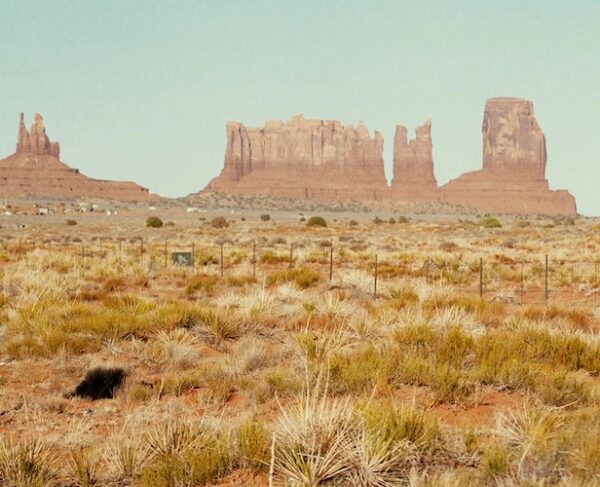Film Review: “The Taking” — Appropriating Monument Valley?
By Gerald Peary
Most of this documentary is so beautiful the temptation is to switch off the preachy, didactic soundtrack and just watch and watch.

A shot of Monument Valley in The Taking.
Alexandre O. Phillipe’s documentary The Taking (currently screening in new York and Los Angeles) is a film historian’s visit to Monument Valley, the glorious Utah locale where John Ford shot seven of his western classics, from Stagecoach (1939) to Cheyenne Autumn (1962), and most famously The Searchers (1956). Phillipe’s choice of title seems to indicate a revisionist documentary, that the filmmaker will roundly condemn the esteemed filmmaker for appropriating Monument Valley, located on Navajo territory, as the land of John Wayne, for shutting out Native Americans except as villains and marauders in his movies. The thesis is offered many times in the documentary by academics in voiceover including by two women native scholars. “This is not native space the way John Ford sees it,” says one of the professors. “What [natives] see is the US attacking our people…The West is a white idea entirely generated by a culture industry…to tell a particular story of the American past in which whites are heroic brave, and innocent.”
But Phillipe is schizoid. An opposing thesis is also posited many times in voiceover by competing academics: that Monument Valley is a mythic land used brilliantly by the great John Ford in offering his personal, abiding vision of American history. A Ford acolyte: “He built us a mental West.”
So where does the filmmaker stand? Anywhere? It makes for a confusing documentary.
While scholars incessantly argue on the soundtrack pro and con about John Ford (there are no talking heads), Phillipe displays on screen a gorgeous, impeccably researched montage of shots of Monument Valley, mostly from Ford but also from many other films and filmmakers, also animation, advertisements, even a George Herrmann Krazy Kat sketch of a cartoon. Most of these images are so beautiful the temptation is to switch off the preachy, didactic soundtrack and just watch and watch. The problem with turning The Taking into a silent film is that, occasionally, something extremely interesting is revealed in the narration, even for those quite familiar with Ford’s cinema. I found it very educational to be shown how the same Monument Valley formations were used in various Ford films, and to learn that this Utah locale was relocated to Texas (The Searchers), Arizona (My Darling Clementine), Oklahoma and Nebraska (Cheyenne Autumn).

Where Forrest Gump ended his cross-country run in Monument Valley. Photo: The Taking.
Monument Valley trivia: A sign with sneakers stands marking where Forrest Gump ended his cross-country run. Tracks remain from where Sergio Leone placed his camera when he traveled from Italy to make Once Upon a Time in the West.
How do I, a great admirer of Ford, also stand when it comes to acknowledging his racism and anti-Native positions? It depends for me on the movie or, more accurately, which part of the movie. What is ever-fascinating about Ford is his contradictions, which feel like America’s contradictions. How he can, for instance, condemn Ethan’s racism and ethnic cleansing in The Searchers and, in the same picture, seem to find it hilarious when his protagonists push an unfortunate Native woman down a hill.
Gerald Peary is a Professor Emeritus at Suffolk University, Boston; ex-curator of the Boston University Cinematheque; and the general editor of the “Conversations with Filmmakers” series from the University Press of Mississippi. A critic for the late Boston Phoenix, he is the author of nine books on cinema; writer-director of the documentaries For the Love of Movies: The Story of American Film Criticism and Archie’s Betty; and a featured actor in the 2013 independent narrative Computer Chess. His latest feature documentary, The Rabbi Goes West, co-directed by Amy Geller, has played at film festivals around the world.
